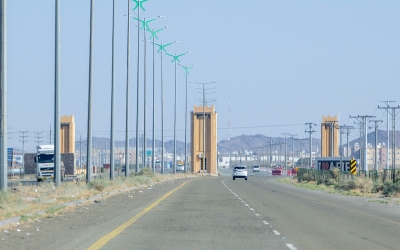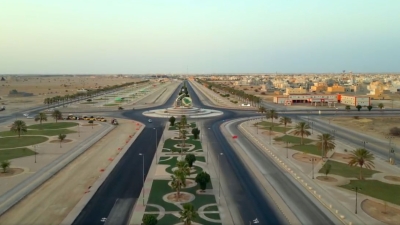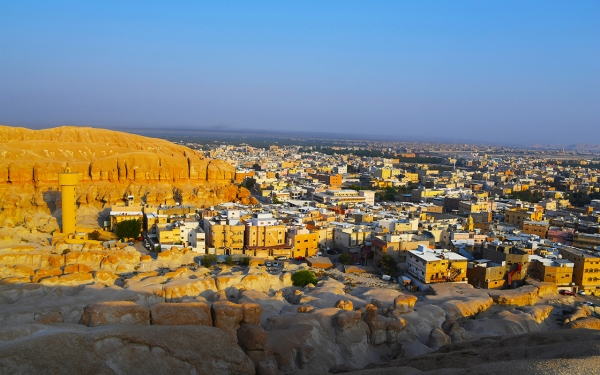
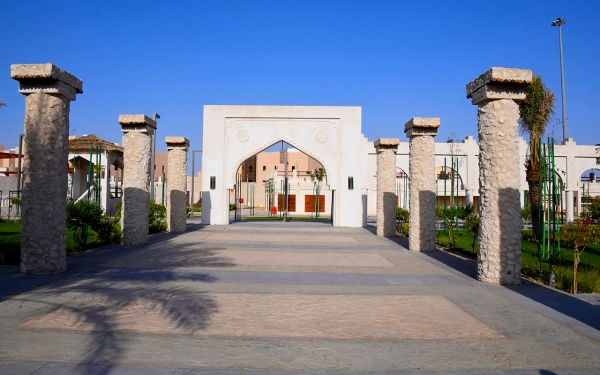
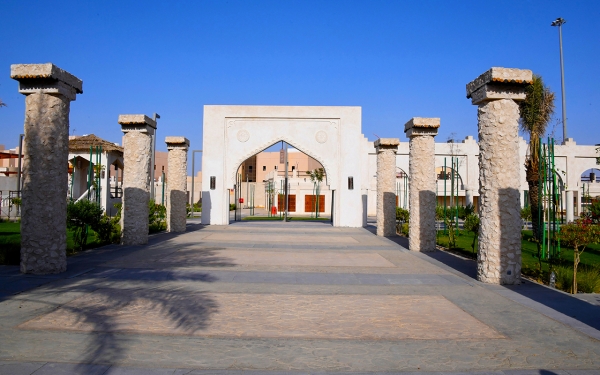
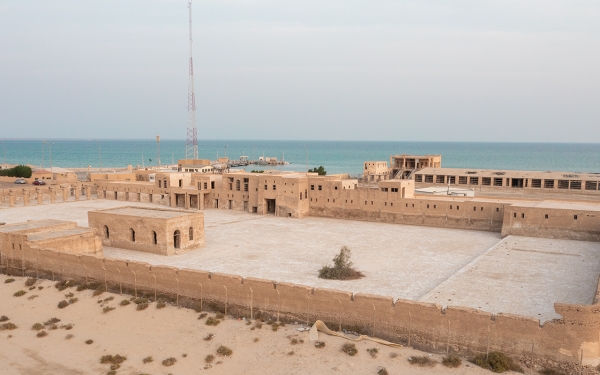
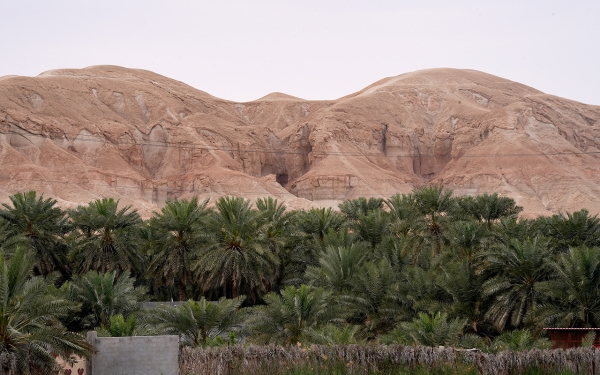
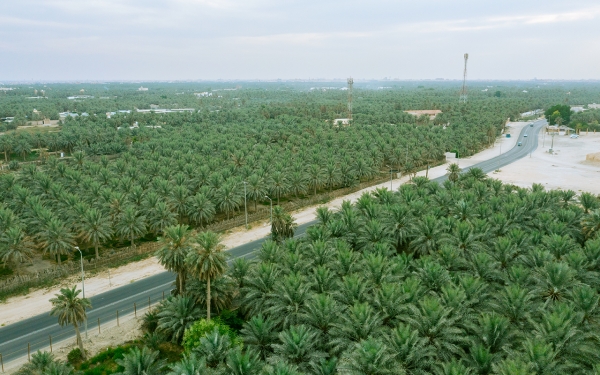
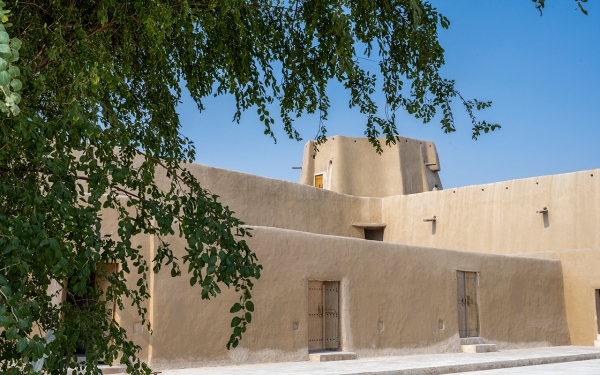
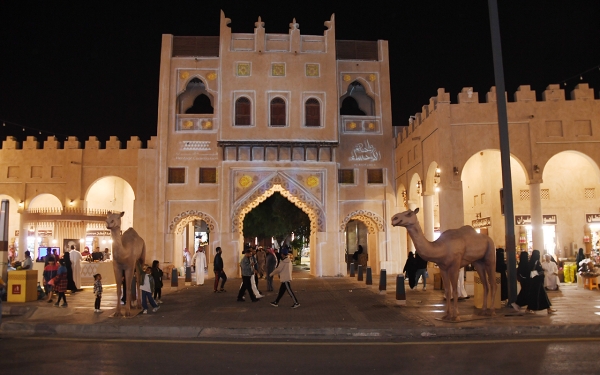
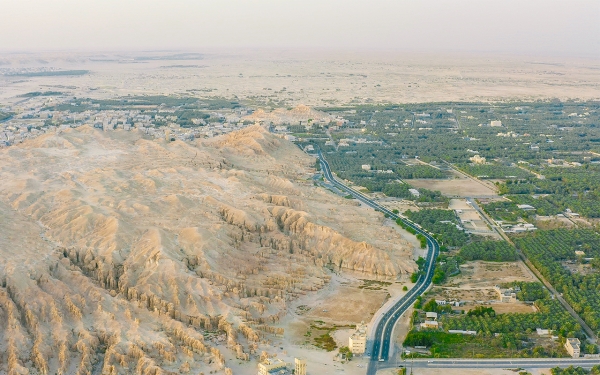
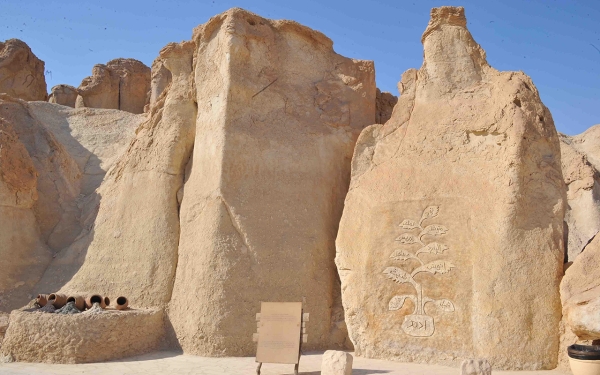
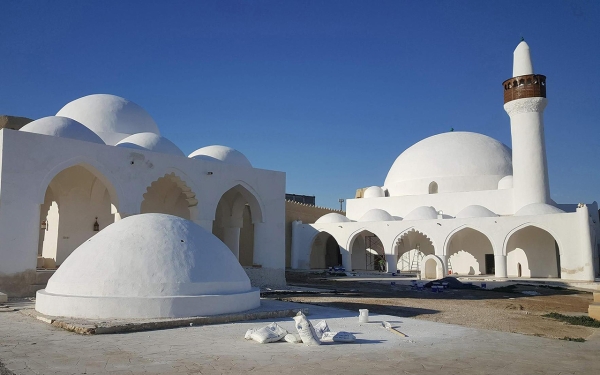
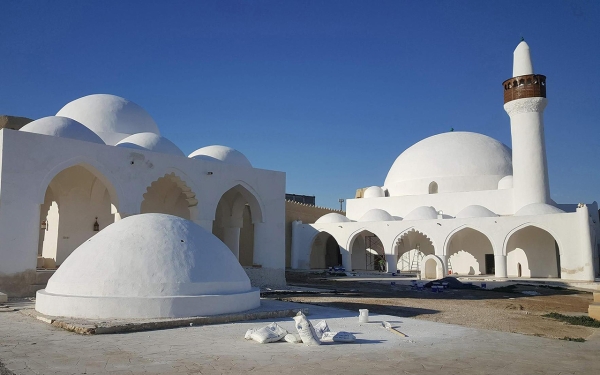
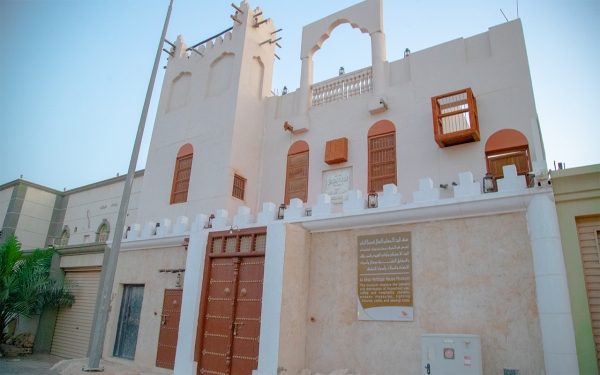
Al-Ahsa Governorate (romanized: Muḥāfad͟hat al Aẖsāʼ) is one of the governorates of the Eastern Province in the Kingdom of Saudi Arabia. It is the largest Saudi governorate in terms of area and the sixth in terms of population among the governorates and cities of the Kingdom. It includes al-Ahsa Oasis, which was registered on the UNESCO World Heritage List as the fifth Saudi site to be recorded on the list.
Overview of al-Ahsa
Al-Ahsa has experienced numerous migrations and settlement shifts throughout its history, due to its favorable geographic location and fertile agricultural land, which have played a key role in the stability of its societies. Al-Ahsa went through eras of prosperity. During the tenth century, a period of peak Islamic civilization, arts, and sciences, al-Ahsa emerged as a significant center that influenced political, military, economic, and social spheres across the Arab and Islamic world. It boasted advanced industries, including textiles, which were exported to neighboring areas. Notably, al-Ahsa produced al-Kaaba's Kiswa (covering), which was sent to Makkah al-Mukarramah, from 1806 to 1812. The diverse population and resources led to various systems of governance in al-Ahsa until it joined the Saudi State, marking the beginning of development across multiple sectors.
Al-Ahsa Governorate possesses elements of comprehensive development. It houses seventy-one diverse government hospitals and clinics, along with specialized hospitals. Additionally, the governorate is characterized by a well-established road network, notably the outer ring road around al-Ahsa Oasis and the inner ring road around the urban center of al-Ahsa (King Abdullah Ring Road). It also includes a range of arterial and main roads that connect the different parts of the urban center.
Al-Ahsa is connected to other regions of the Kingdom and the world via maritime ports, including the historic al-Uqayr port. In terms of air travel, there is an international airport located fourteen km from the city of Hufuf, which was inaugurated in 1949. There are also railway lines in the urban center of al-Ahsa coming from the west and southwest direction from Riyadh, which then head north to Dammam.
Al-Ahsa Designation
The influence of the location is evident in the interpretations of the designation of al-Ahsa for this geographic spot. Al-Ahsa is the plural form of Hasi, which means the sound of water underground., prompting the Arabs to dig and extract it. Al-Ahsa, also known as al-Hasa, designates the eastern region. This province is bordered to the west by Aqbat al-Furuq ksobor, to the north by al-Qatif and Judah, to the east by the sands of al-Uqayr, and to the south by the sands of Yabrin. Yaqut al-Hamawi stated: Al-Ahsa was initially built, fortified, and made into a fort by Abu Taher al-Hasan Bin Abi Said al-Janabi al-Qarmati on the ruins of the city of Hajar in 930.
Another common name among the residents of the governorate is al-Hasa, derived from al-Hisi, which refers to rocky land covered with a layer of sand that stores rainwater. In these areas, water can be accessed by digging to a very shallow depth.
Administrative division of al-Ahsa Governorate
Al-Ahsa Governorate, classified as a Category (A) governorate in the Eastern Province, is composed of several key cities, including al-Hufuf and al-Mubarraz, along with a collection of recognized centers, hamlets, and towns. Al-Ahsa encompasses twenty-two administrative centers, of which sixteen are Category (A) centers: Judah, Uray'irah, Yabrin, al-Khinn, al-Hafayir, al-Ghuwayba, Umm Rubay'a, Umm Athlah, al-Uyun, al-'Udayliyyah, Harad, Khurays, al-Uqayr, Fadhila, Umm al-Arad, and Shuja’a Hamlet. Additionally, there are six Category (B) centers: az-Zaydiyyah Hamlet, al-Sayh Hamlet, al-Tawilah, Muraytibah, al-Daho, and al-Salmiyah.
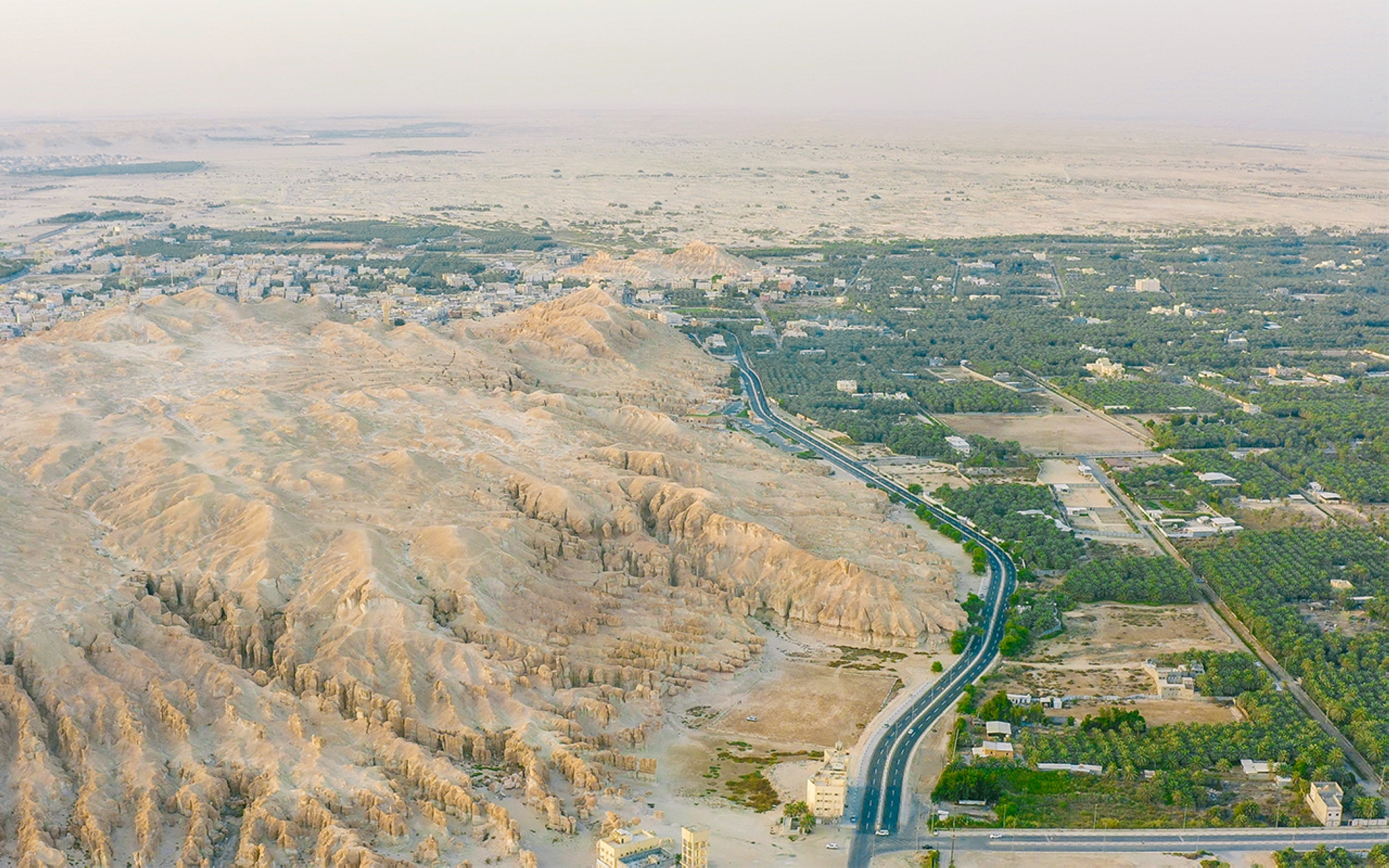
Geography of al-Ahsa Governorate
Al-Ahsa Governorate is located on the east and southeast of the Kingdom. This position has offered the governorate several advantages, making it a destination for successive historical migrations and a land for various civilizations.
Location and area of al-Ahsa Governorate
Al-Ahsa is located in a distinguished geographical position in the central part of the western coastal plain of the Arabian Gulf. It is situated in the southwestern corner of the Asian continent and the southeastern corner of the Kingdom. Al-Ahsa occupies the southern part of the Eastern Province, located between latitudes 17-26 and longitudes 48-55.
According to its geographical surroundings, al-Ahsa is approximately forty km away from the Arabian Gulf, 150 km south of Dammam City, and 320 km east of Riyadh City. As per the administrative distribution of the Kingdom's provinces, its borders are defined by the governorates of Dammam, Buqayq, an-Nu'ayriyyah, and Qaryat al-Ulya to the north. It is bordered by the Arabian Gulf to the east, ar-Rub' al-Khali (Empty Quarter) to the south, and ad-Dahna' Desert and Summan Plateau to the west. Al-Ahsa is distinguished as it connects the Kingdom with the Arabian Gulf.
As the largest governorate in the Kingdom, al-Ahsa spans an extensive area of around 375,000 km, accounting for 69 percent of the Eastern Province's area. It encompasses four main cities: Al-Hufuf, al-Mubarraz, al-Uyun, and al-Omran, along with forty villages. Approximately 96.3 percent of the governorate's population resides within al-Ahsa Oasis.
Advantages of al-Ahsa Governorate's location
Al-Ahsa Governorate boasts a strategic position endowed with numerous advantages related to its natural resources and capabilities. It is considered the largest palm oasis in the world and is located on the world's largest oil field (Ghawar Field).
Despite the vast deserts surrounding the governorate, its 150 km stretch of beaches along the Arabian Gulf enhances its touristic appeal. Notably, al-Uqayr Beach, located in al-Uqayr, Salwa, and al-Batha areas, lies just eight km from al-Hufuf city and 150 km from Salwa Beach near the Saudi-Qatar border. It boasts Saudi coastlines overlooking the Arabian Gulf, particularly around the islands and nature reserves near al-Uqayr, which serve as a sanctuary for migratory birds.
Cities and villages of al-Ahsa Governorate
Al-Ahsa Governorate is distinguished by a number of historical cities and villages, some of which have become tourist destinations due to the availability of heritage and archaeological sites that date back to various eras and periods. The governorate has four main cities and forty villages, with distances between them ranging from two to five km. Additionally, there are fifty-five hamlets dispersed throughout the governorate at a rate of one hamlet for every ten thousand km², with an average population of five hundred residents per hamlet. The average distance between these hamlets is about 250 km.
Al-Ahsa's key cities include:
Al-Hufuf: It is the administrative capital of the governorate and the seat of its administrative governance. Commercial activities thrive here.
Al-Mubarraz: The second-largest city in al-Ahsa, it was built over the ruins of Umran Dars. The discovery of ancient settlement relics of this ancient city attests to this.
History of al-Ahsa Governorate
The history of al-Ahsa Governorate extends back to periods before the Common Era. It is one of the oldest settlements in the world and has been home to various ancient civilizations. The population of al-Ahsa was estimated to be around one hundred thousand inhabitants during the period from 1000 to 1200. This number was comparable to the population of ancient cities like Thebes in Egypt, Babylon in Iraq, and Yangzhou in China.
Al-Ahsa maintained its heritage over time until it came under the flag of the founder King Abdulaziz Bin Abdulrahman Al Saud. The city of al-Hufuf, originally called al-Ahsa, remained the capital of the Eastern Province until 1953, when the emirate's headquarters were moved to Dammam.
Demographics of al-Ahsa Governorate
Al-Ahsa Governorate has witnessed significant population diversity throughout history. Scholars suggest that the eastern and southeastern parts of the Arabian Peninsula were the original homeland of the Semitic races, such as the Arameans, Phoenicians, Chaldeans, and Assyrians. Ancient historians indicated that Yabrin, located south of al-Ahsa, was among the settlements of the descendants of Sam, son of Noah. Some clans from the Ad tribe also inhabited it.
Migration to al-Ahsa did not cease. Among the migrations were the Arab tribes that settled in it. The Quda'a and al-Azd tribes settled there at the beginning of the Gregorian era. Then came the tribe of Bani Abd al-Qays, one of the most famous Arab tribes that inhabited the region before Islam. Some of their most renowned markets were Souq Hajar and Jawatha.
Amidst the migration movements, al-Ahsa was formed as a result of the amalgamation of several neighboring small colonies to form a single, larger municipality. The initial urban centers tended to gather near water resources, such as wells and springs scattered throughout the region, leading to the emergence of small agricultural communities around them.
With the prosperity of the Kingdom, al-Ahsa Governorate became an urban center in the Eastern Province. It is composed of key cities, including al-Hufuf, al-Mubarraz, al-Uyun, and al-Omran. Al-Ahsa Governorate is located within al-Ahsa sector and accounts for 25.7 percent of the province's population, ranking second after the coastal strip, which comprises 61.5 percent of the province's population. The primary economic activities of this sector include agriculture, tourism, and manufacturing. According to the 2022 census, its population is 1,104,267 people, constituting 3.4 percent of the Kingdom's population and ranking sixth among the governorates and cities of the Kingdom. It follows Riyadh (seat of the Emirate of Riyadh Province) with 7,009,120 residents, Jeddah Governorate with 3,751,722 residents, Makkah al-Mukarramah (seat of the Emirate of the Makkah al-Mukarramah Province) with 2,427,924 residents, Dammam (seat of the Emirate of the Eastern Province) with 1,532,326 residents, and al-Madinah al-Munawwarah (seat of the Emirate of the al-Madinah al-Munawwarah) with 1,477,047 residents.
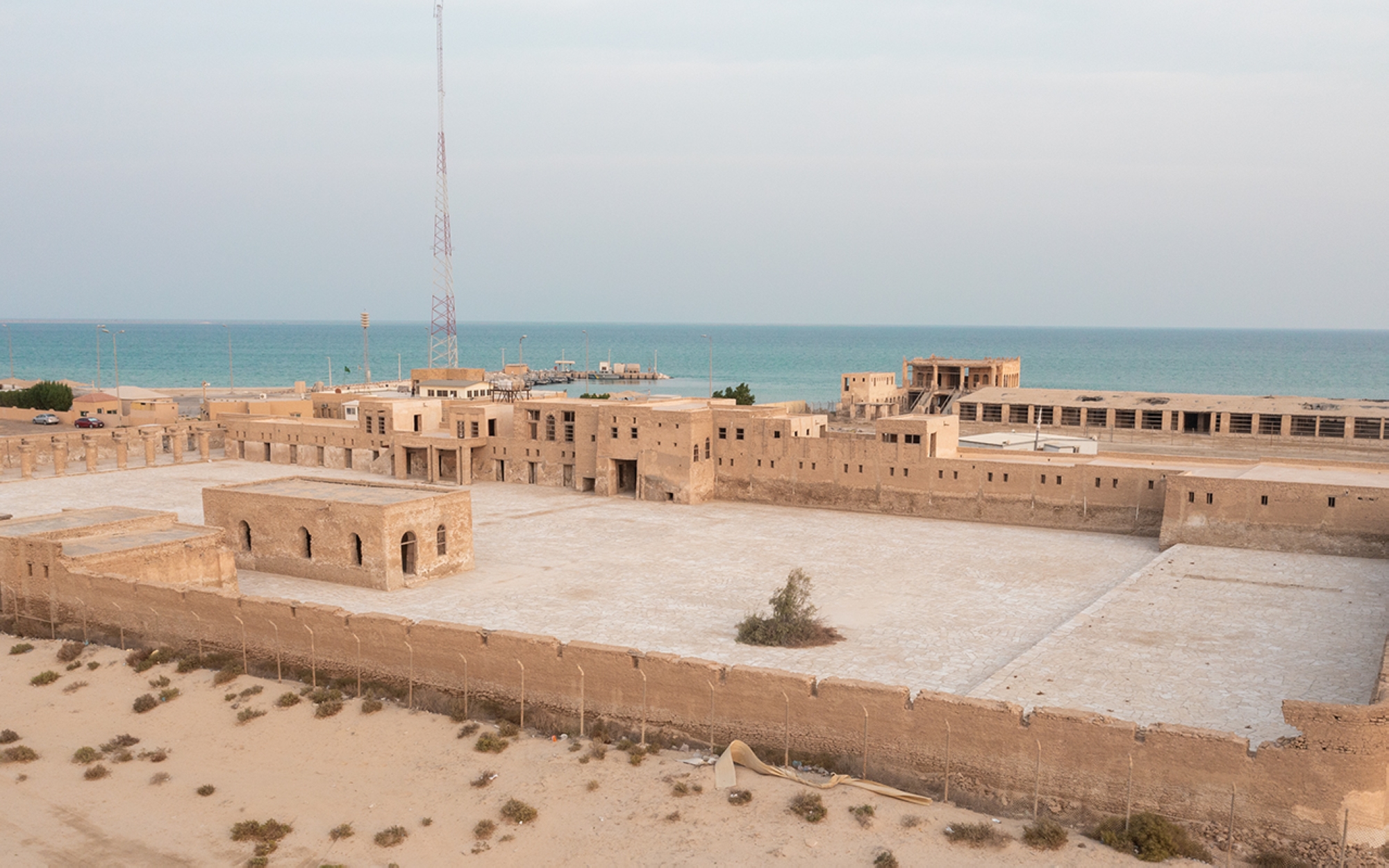
Civilizations of al-Ahsa Governorate
Numerous civilizations succeeded one another in al-Ahsa Governorate, which was one of the historical human settlement regions over the ages. Perhaps the archaeological discoveries, which date back more than five thousand years BCE, are a testament to this.
In addition to its natural resources, al-Ahsa represents a convergence point for land routes between the central and eastern parts of the Arabian Peninsula. It is also where land meets sea through al-Uqayr Port. As such, al-Ahsa played a fundamental role as a connecting link between some civilizations like the Babylonian and Sumerian civilizations in Iraq to the north, the Phoenician civilization on the eastern Mediterranean, the civilization of the Nile Valley to the west, the Persian and Indian civilizations to the east, and the civilizations of Yemen and Oman to the south. This is clearly visible in al-Ahsa's traditional architecture's influence by these civilizations.
Al-Ahsa attracted many people due to the conditions it offered for settlement. The Canaanites are historically noted as the first inhabitants of al-Ahsa after they migrated from the central part of the Arabian Peninsula. They were drawn by the springs of fresh water. Among their descendants were the Phoenician giants who were renowned for agriculture, irrigation affairs, adventures, seafaring, and trade. Chaldean migrants from Babylon also arrived in al-Ahsa and established a city near al-Uqayr named al-Jahra', which became a significant commercial hub.
Given its historical and civilizational position, al-Ahsa continued to coexist with multiple civilizations. Its land was inhabited by several different races and ethnicities. In fact, during the first millennium, al-Ahsa was among the top fifteen cities in terms of population size, ranking ninth among cities with a population density of 110,000 inhabitants.
The diverse settlement in al-Ahsa Governorate
The varied settlement history in al-Ahsa Governorate led to the establishment of governance systems that organized the lives of its residents from prehistoric times up to the emergence of Islam. The region was under the rule of the Bani Abd al-Qays, who voluntarily embraced Islam. The Prophet Muhammad, peace be upon him (PBUH), spoke highly of them, stating, "How good are the people of Abd al-Qays!" The Bani Abd al-Qays constructed the first mosque in al-Ahsa, located in the city of Jawatha (Jawatha Mosque).
The people of al-Ahsa quickly embraced Islam when it emerged and continued to support the Islamic state, particularly in its early formation, contributing significantly from an economic perspective due to the region's rich agricultural resources.
Al-Ahsa experienced various periods of rule, including the era of the Qarmatians who settled in Jawatha, followed by the Uyunid and Jabrid dynasties, which governed the area before the arrival of the Ottomans between 1439 and 1526. The region later became part of the First Saudi State in the late eighteenth century and remained under the control of both the First and Second Saudi States. After the fall of the Second Saudi State, al-Ahsa left Saudi rule until it was reclaimed by King Abdulaziz in 1913
The annexation of al-Ahsa to the Saudi State
King Abdulaziz succeeded in regaining al-Ahsa from the Ottomans after around forty years of occupation. In April 1914, after al-Ahsa came under his authority, King Abdulaziz met with representatives of the British government in Kuwait, in Malah. This meeting served as a prelude to the signing of a treaty with the British government on December 26, 1915, in Darin, Tarut Island. Thus, King Abdulaziz was able to incorporate al-Ahsa into Najd, making it a region in the Kingdom.
Al-Ahsa's integration into the Saudi State is tied to the House of Allegiance, now a notable archaeological site in the province. In 1913, after the conquest of al-Ahsa, King Abdulaziz stayed at this house as a guest of Sheikh Abdul-Latif Bin Abdulrahman al-Mulla. On that night, King Abdulaziz received the pledge of allegiance from the people of al-Ahsa, committing to upholding the Book of Allah and the Sunnah of His Messenger. He spent the night in one of the rooms alongside his brothers Mohammed, Saad, and Abdullah.
After al-Ahsa joined the Saudi State, it experienced significant development across various sectors and was established as one of the governorates of the Eastern Province, equipped with the elements needed for a renaissance.
In 2022, a Royal Order established al-Ahsa Governorate Development Authority, tasked with maximizing the governorate's great potential. This authority focuses on developing the region's natural, tourist, heritage, and cultural assets, contributing to a balanced and sustainable development environment that supports the local economy and promotes growth, modernization, and diversity.
Geology of al-Ahsa Governorate
The geological nature of al-Ahsa Governorate is characterized by a level surface and a slight slope towards the east and northeast. This facilitated the flow of irrigation water in channels, transporting it to farms, which aided in settling the land and the spread of holdings. This resulted in the formation of a large number of villages and farms. The flat terrain, combined with the abundance of water from wells and springs, assisted in the settlement of the inhabitants. With this settlement, there arose a need to secure crops, produce, and homes.
Terrain of al-Ahsa Governorate
The topographical features of al-Ahsa are divided into three main terrains: plateaus, deserts, and plains, in addition to salt flats and valleys. The elevation of the governorate ranges from seven hundred m to zero above sea level. Generally, the land of the governorate is flat and slopes towards the east.
Sand dunes are abundant in al-Ahsa Oasis from the north, east, and south. These dunes are made up of loose, brittle sand with no solid structure. This provided al-Ahsa with a natural barrier, preventing external raids from attempting to take over or cross it to reach the central part of the Arabian Peninsula. In addition to natural fortifications, represented by deserts and salt flats, human-made fortifications also played a role, embodied in the castles and forts built in the north and west of the oasis, surrounded by dense palm farms, forming a defensive line difficult to breach.
Al-Ahsa Oasis is characterized by the presence of abundant underground water resources, which include numerous wells and springs. These are perennial waters with a natural flow, equivalent to the flow of a medium-sized river. In addition, the oasis soil is highly suitable for agriculture. It predominantly consists of sandy loam formations and clayey sand formations, underlain by a layer of silt ranging in depth from forty cm to three hundred cm.
The climate of al-Ahsa
The climate of al-Ahsa is influenced by its geographical location and topography. It has a hot, arid climate during the summer, while the winters are cold and rainy. The region often experiences clear, sunny weather. It receives seasonal rainfall during the fall, and it is occasionally affected by sandstorms. The density of palm trees contributes to moderating the climate, especially in agricultural areas during summer nights.
In general, al-Ahsa has a continental climate, characterized by extreme temperature variations, which is typical of many regions in the country. The summer temperatures can reach up to forty-eight degrees Celcius, while in winter, they can drop to around ten degrees Celcius.
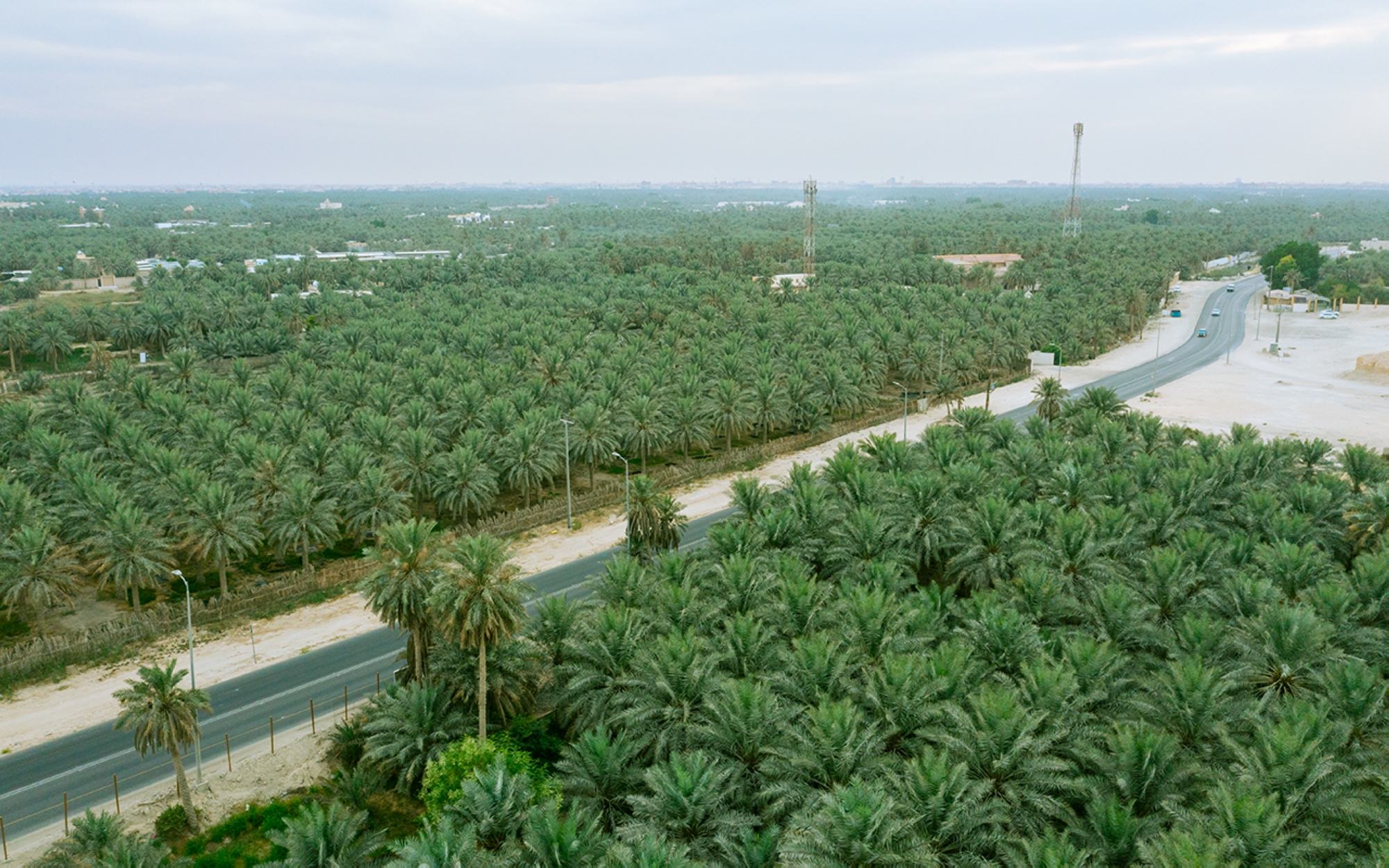
Economy of al-Ahsa Governorate
The economy of al-Ahsa Governorate relies on its abundant natural resources and its strategic geographical location, resulting in extensive trade activities organized by the Chamber of Commerce, which was established in 1982. This Chamber was the cornerstone for the development of the private sector in al-Ahsa Governorate.
A prominent historical landmark in al-Ahsa is al-Uqayr port, which is considered the oldest seaport in the Kingdom. It was the main port for successive civilizations and was established in 960. It was named al-Uqayr or al-'Ajeer, as locals of al-Ahsa call it, after the tribe of 'Ajeer that inhabited the region during the first millennium BCE. Today, the port is no longer in regular use and has transformed into a tourist and historical site.
Agriculture in al-Ahsa Governorate
Agricultural activity has been a prominent economic activity in al-Ahsa throughout its history. This is due to the abundance of groundwater springs and fertile soil. Apart from these, the region is renowned for its high-quality dates. Due to this agricultural wealth, its proximity to premium pearl diving areas, and its central position between several civilization centers, al-Ahsa has played a tangible role in consolidating trade and cultural relationships between the Arabian Peninsula, Mesopotamia, India, and Asia. It acted as a linchpin in the exchange of goods and expertise between these regions.
Currently, al-Ahsa represents a vast green agricultural oasis and an essential source of food security in the Kingdom. It encompasses over two and a half million palm trees, producing around one hundred thousand t of the finest varieties of dates annually. This production has contributed to the Kingdom becoming a leading global exporter of dates with exports valued at over SAR1 billion. The National Center for Palms and Dates has achieved the top global position in exporting dates to 113 countries.
Due to its geographical diversity and its proximity to the Arabian Gulf, al-Ahsa has been a trading station for many ancient caravans, establishing itself as a significant location for the trade and sale of dates, spices, and incense. It became a market for visitors coming from Asian countries, the Horn of Africa, Mesopotamia, the Levant, and the Arabian Peninsula. To enhance its agricultural activities, three programs were inaugurated in the sectors of environment, water, and agriculture. These are: Sedrah, dedicated to the environmental sector, Sahabah, designated for the water sector, and Sunbolah, focused on the agricultural sector.
In the context of efforts to achieve a sustainable environment with natural resources and food security, and within the framework of Saudi Vision 2030 and its strategic objectives, al-Ahsa Governorate's local agricultural output in 2022 achieved approximately thirty thousand t of grains, 170,000 t of vegetables and fruits, 126 million liters of dairy products, and 44,000 t of poultry. This has increased production efficiency and raised the self-sufficiency rate of agricultural products to reach 65 percent.
Oil in al-Ahsa
Al-Ahsa Governorate is home to several oil and gas fields, whose discovery has played a significant role in determining the development pattern and growth of the governorate. Classifying al-Ahsa as a national growth center has had a positive impact, driving and stimulating growth in al-Ahsa.
Al-Ahsa Governorate's production accounts for 60 percent of the Kingdom's total output. It is home to the most important oil field, Ghawar Field, which is located to the east of al-Hufuf City and spans a length of 280 km and a width of 26 km. Its daily production is estimated at around 3.8 million bbl of oil. The field has produced more than 127.7 billion bbl of crude oil since it began operating in 1951 until 2018.
Industry in al-Ahsa Governorate
With agricultural and oil activities in al-Ahsa Governorate, industrial production in the governorate has expanded. From agricultural raw materials, handicraft industries reliant on palm trees emerged, such as date production and its industry, and the crafting of ceilings and furniture from palm trunks and fronds. The region also developed ceramics and pottery industries based on the clay soil in al-Ahsa, and pearl fishing from the waters of the Arabian Gulf. Al-Ahsa played a prominent commercial role throughout historical eras, serving as a trading center connecting the north and south of the Arabian Gulf. It was also the main commercial outlet for the central and eastern parts of the Arabian Peninsula to the Arabian Gulf, East Asia, and Africa. Al-Ahsa is distinguished by its diverse markets, such as Hajar, al-Jura'a, al-Mashqar, al-Zarat, and Darin markets.
The industrial activity expanded with the construction of industrial cities that embrace various industries, prominent of which are: cement manufacturing and the packaging and wrapping of dates, in addition to other small and artisanal industries. The first industrial city in al-Ahsa was established in 1981 in al-Uyun City. It covers an area of 1,500,000 m² and houses 142 industrial and service contracts, including those in production, already established, under construction, and in the foundational stage.
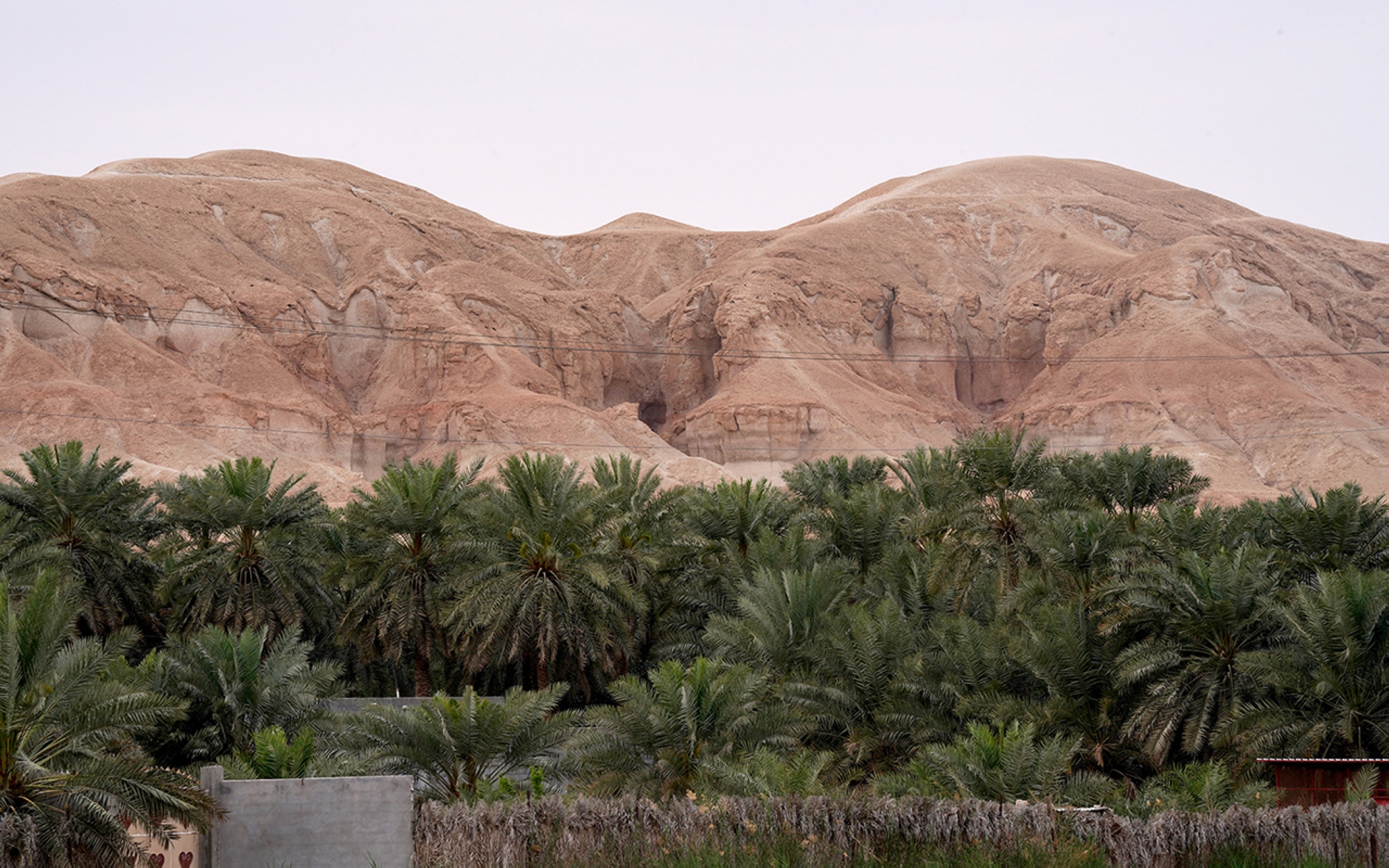

Al-Ahsa Oasis
Al-Ahsa is famous for its Oasis, which is considered one of the largest natural palm oases in the world. The number of palm trees in the Oasis is 2.5 million, producing about thirty-four varieties of dates. Its total annual production is approximately 110,000 to 120,000 t, representing nearly 10 percent of the Kingdom's date production.
The types of dates—Khlas, Razez, and Shishi—account for about 75 percent of al-Ahsa's total production, contributing to the flourishing date industry. The number of licensed factories in the governorate exceeds thirty factories, with 90 percent of them being packaging factories.
Other types of dates in al-Ahsa include: Zamli, Shabibi, Hilali, Marzban, Tayyar, al-Ghar, Kasbi, Khunaizi, al-Khasab, al-Wasili, Tanajib, Zambour, Hatami, Barhi, Tabili, Umm Rahim, al-Majnaz, Shahl, Adhabi, and others.
Springs of al-Ahsa Governorate
The springs of water in al-Ahsa have been one of its historical features attracting migrations to the region. They are abundantly distributed in various locations of the towns and villages of al-Ahsa, such as Ain al-Khodoud east of al-Hufuf, Ain al-Jawharia in al-Battaliyah village north of al-Hufuf, Ain Umm Saba'a in al-Qarin village north of al-Mubarraz, and Ain al-Harrah, which is known for its hot water and is located in the center of al-Mubarraz City.
Al-Ahsa is famous for its abundance of water through these springs, which number more than thirty. These springs are used to supply the agricultural area with water through a series of channels and streams, forming the traditional irrigation network. This includes Bahla, al-Buhayriyyah, al-Qurayyat, al-Haql, al-Harrah, al-Huwayrat, al-Jawharia, al-Khodoud, Umm Saba’a, Sawaydrah, and Ain Najm, which has hot sulfurous water and has been transformed into a tourist resort.
Education in al-Ahsa Governorate
Al-Ahsa has long been a beacon of culture and education. It established al-Kuttab and schools from early periods, making it an educational destination.
General education
In al-Ahsa Governorate, many historical schools emerged. Among them is al-Amiriah School, which is considered a tourist landmark in al-Ahsa. It dates back to the 1940s, with its two-story gates and balconies featuring a distinctive architectural design. The school consists of two wings that house several spacious large rooms.
Al-Amiriya School is located in al-Hufuf City, in the old al-Koot District, covering an area of approximately 2,056 m². Established in 1937, it is the first Saudi government school in al-Hufuf. The school building was officially opened in 1941, and was later named al-Hufuf First School, and also called the “House of Culture.”
Other schools also emerged, including al-Qubba School in al-Koot District of al-Hufuf, established on October 18, 1610. This school is recognized as the oldest independent scientific institution in the eastern Arabian Peninsula and the Arabian Gulf, specializing in teaching Islamic sciences and the Arabic language. Additionally, al-Shalhoubiyah School was founded in 1769 with a focus on jurisprudence and Islamic studies, as well as al-Shaharna School, established in 1785 in al-Rafa’a Neighborhood of al-Hufuf, and al-Sharifa School, established in 1887, is also regarded as a significant scientific landmark. Sheikh Hamad Bin Mohammed al-Naeem established al-Najah National School in 1925 in al-Naathel Neighborhood, located in the heart of al-Hufuf City. The school was visited by the founder King Abdulaziz Bin Abdulrahman Al Saud in 1930.
Higher education
In al-Ahsa Governorate, there is a vast sector for higher education comprising thirty-six universities and technical, vocational, and training institutes across various scientific fields.
King Faisal University is a higher education institution in the governorate. Established over an area of about 480 ha (4.8 km) in 1975, it encompasses fifteen colleges, fourteen centers, and one institute. It caters to regular students, as well as students in bachelor's programs, university diploma stages, and postgraduate studies. There is also a branch of Imam Mohammed Bin Saud Islamic University represented by the College of Sharia and Islamic Studies.
Tourism in al-Ahsa Governorate
Al-Ahsa boasts a tourist and heritage attractions that make it a unique tourist destination. Its tourist and heritage resources range from archaeological and historical sites, palaces, and castles, to mosques, natural wonders, wildlife, parks, lakes, cultural heritage, and museums.
While these landmarks are spread throughout al-Ahsa, approximately 80 percent of the heritage buildings are located in al-Ahsa's urban region, particularly within the historical centers of al-Hufuf and al-Mubarraz. This wealth of landmarks and sites, al-Ahsa has become a historic witness of the transformation into a cultural and tourist destination, earning it the title of 'Capital of Arab Tourism' in 2019.
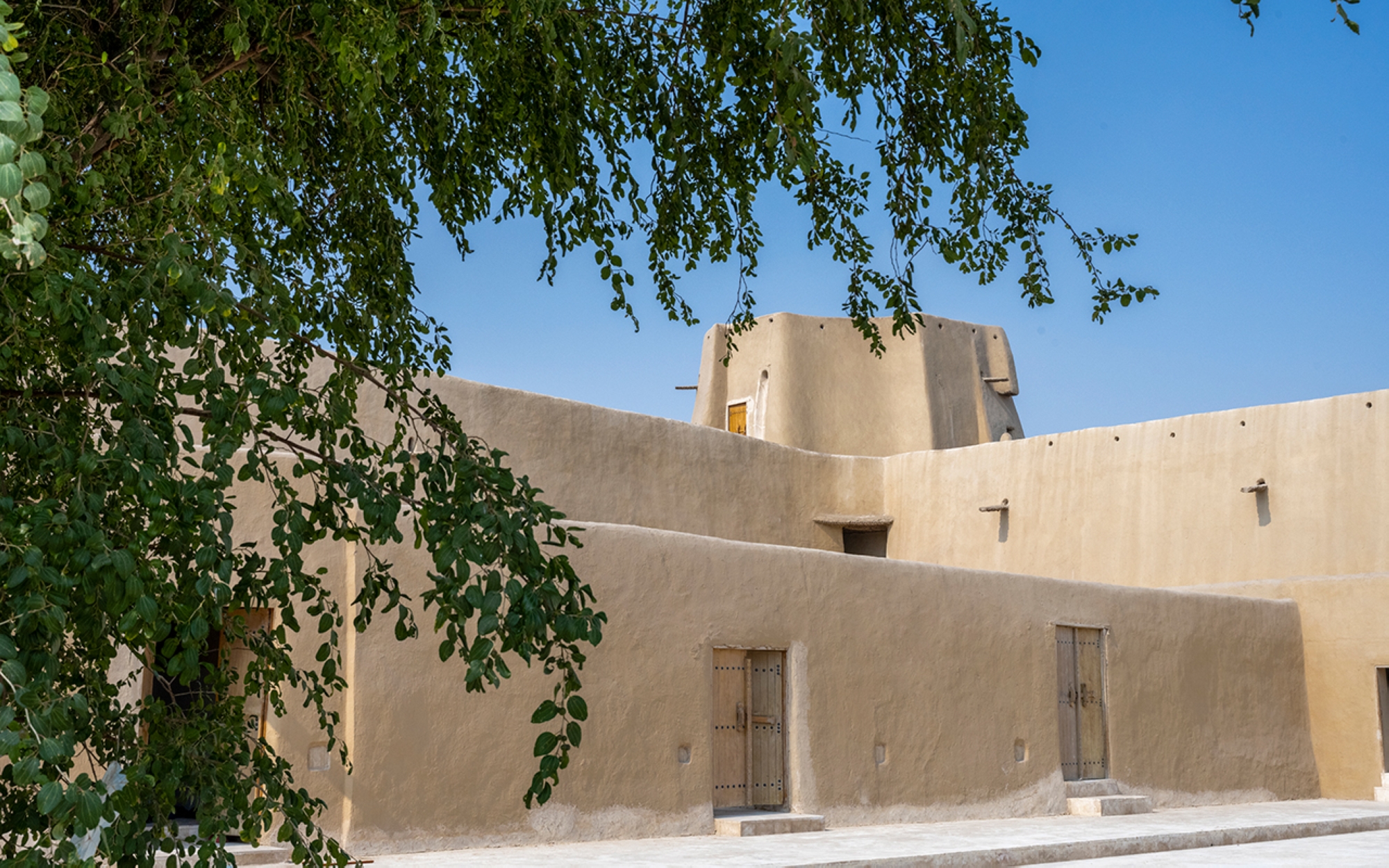
Archaeological sites in al-Ahsa Governorate
The coast of al-Uqayr is considered one of the most beautiful coasts in the Kingdom. It stands out due to the intermingling of the Gulf waters with its shallow sandy beaches, the diversity of its geographical features, and the abundance of capes, bays, and islands. Islands in al-Uqayr include al-Zakhounia Island and al-Futtaim Island. There's also the Dougah al-Gharash, which dates back around six hundred years. This Dougah is known as a place where pottery is burned, making it an archaeological landmark in al-Ahsa.
Al-Ahsa Governorate is rich in several prominent heritage sites, such as the House of Allegiance, al-Amiriya School, Muhairis Palace, Ibrahim Palace, Ain Najm, and the traditional al-Qaisariyah Market.
Historical Ibrahim Palace
Located in al-Koot District in the center of al-Hufuf, it spans an area of about 18,200 m². It was named after Ibrahim Bin Ufaysan. It showcases two architectural styles: the Islamic style, evident in the semi-circular arches and prominent Islamic domes in the palace and the Mihrab of the mosque, and the military style, represented by the massive towers surrounding the palace. Additionally, the residential barracks for soldiers, which are located to the east of the palace, and the adjacent horse stables.
Jawatha Mosque
It is among the earliest mosques in Islam. Its construction dates back to the era of the Prophet Muhammad (PBUH) in 628. It is located east of the village of al-Kilabiyah, about eighteen km away from al-Hufuf City. The mosque and its outer courtyard cover an area of around 713 m².
The mosque is the second to have Friday prayers conducted in it after the Prophet's Mosque (PBUH). After that, other mosques were established, such as al-Jabri Mosque, al-Dabs (al-Fateh) Mosque, Abu Jumhoor al-Ahsa'i Mosque, and al-Jami' Mosque in al-Bataliyah.
House of Allegiance
Near the Historical Ibrahim Palace, the house of Sheikh Abdul-Latif al-Mulla is located, known as the House of Allegiance. This house witnessed the first meeting between King Abdulaziz and Sheikh Abdul-Latif al-Mulla, which was followed by the citizens of al-Ahsa pledging allegiance to him, agreeing to hear and obey according to the Book of Allah and the Sunnah of His Messenger. This house serves as a model of traditional architecture in al-Ahsa. The house covers an area of approximately 705 m². It was established in 1788 and was built by Sheikh Abdulrahman Bin Omar al-Mulla, who was the judge of al-Ahsa during that period.
The Eastern Oasis
It encompasses a large section of al-Ahsa's Eastern Oasis, with a total area of 3,885 ha. The site forms an irregular crescent shape, extending about nine km on the north-south axis and about twelve km on the east-west axis. It includes dense palm groves and defined agricultural areas separated by a network of canals. These canals almost entirely surround the oasis, creating a protective boundary.
The Northern Oasis
It covers a significant part of the Northern al-Ahsa Oasis, with a total area of 2,010 ha. It is bordered to the east by the main drainage canal that runs from north to south. The network of canals, which dates back to the 1970s, forms the southern, western, and northern boundaries. The site somewhat represents an almost integrated circular shape.
Al-Sifa Oasis
The oasis aligns with the central sector of al-Sifa Oasis in al-Hufuf and covers an area of about 108 ha of densely planted palm groves.
Sahood Palace
Its construction dates back to 1789. It is a fortress built on a high plateau located on the western side outside the old city of al-Mubarraz, opposite al-Hazm neighborhood in al-Mubarraz. The structure is rectangular and spans an area of 1.2 ha. The fortress was named Sahoud after a large cannon positioned on one of its towers.
Ain Qannas Site
It is an archaeological site that spans 18.8 ha and was excavated in the 1970s. It is recognized as the largest site in the Kingdom associated with the Ubaid civilization. This site's significance stems from its combination of artifacts from both the Stone Age and the Ubaid civilization, which was renowned for its colorful pottery. Pottery shards from the Ubaid period are scattered across the site, covering an area of two km². Excavations were conducted up to a depth of five m, revealing fourteen successive residential layers that illustrate the stages of human settlement at the site.
Al-Jabri Mosque
It is situated in al-Koot Neighborhood of al-Hufuf City and was constructed by Saif Bin Zamil Bin Hussein al-Jabri in 1475 using clay and limestone. Covering an area of approximately 1,426 m, it underwent various restoration and maintenance efforts between (1550 and 2008) to rebuild parts that had been damaged and to preserve its historical character.
Al-Dibs (al-Fateh) Mosque
Located in al-Hufuf City in al-Ahsa Governorate, it is one of the oldest mosques in the city. It was constructed in 1554. The mosque spans an area of about 350 m². It was named al-Dabs because of its proximity to the date market. The mosque serves as a destination for students of the Holy Quran, Hadith, and jurisprudence.
Muhairis Palace
Situated in the north of al-Mubarraz City, the palace was built on a high hill overlooking the city. It is located fourteen km north of al-Hufuf. Without considering its external courtyard, the palace covers an area of about 207.8 m². It was constructed in 1793 during the reign of Imam Abdulaziz Bin Mohammed Bin Saud, the second Imam of the First Saudi State. The structure is a military fortress that includes a watchtower.
Khuzam Palace
Located in the old al-Raqiqa Neighborhood in al-Hufuf City, it was built in 1805 during the reign of Imam Saud Bin Abdulaziz. The palace occupies an area of about 5,600 m². It is smaller than the historical Ibrahim Palace in al-Koot Neighborhood. Its outer walls are estimated to be seventy m by eighty m in length. Although it is called a palace, it is a fortress constructed for the defense of al-Ahsa. Historically, the palace is intertwined with the history of the Saudi State.
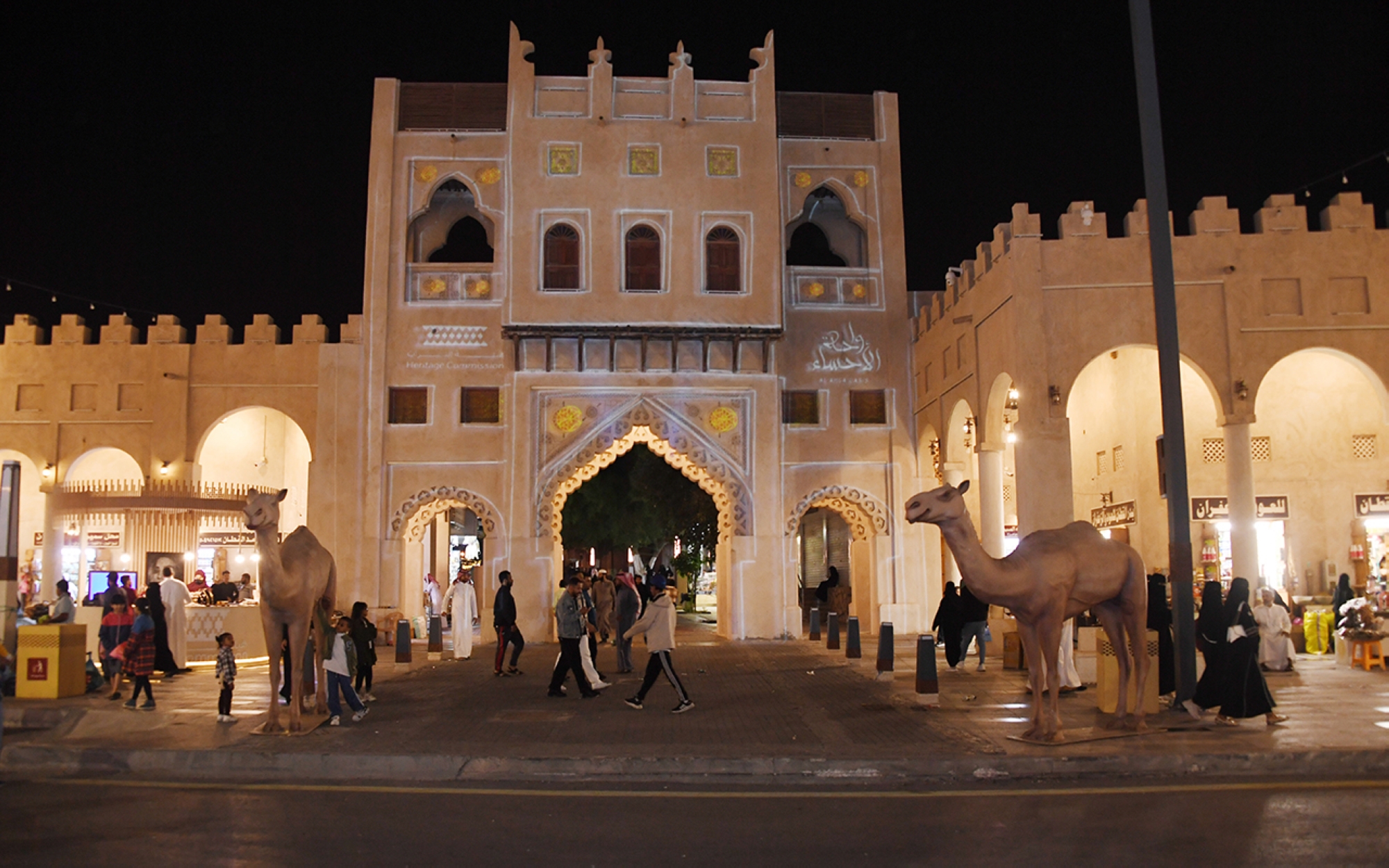
Tourist landmarks in al-Ahsa Governorate
The Touristic City of Jawatha
It is a recreational city located near the historic Jawatha Mosque. The city offers various entertainment activities for both kids and adults, such as an amusement park, a paragliding club, a karting club, a paintball club, maritime boats, children's games, and numerous restaurants and cafes. The city also features the traditional Hajar Market.
King Abdullah Park
It is a public park located south of al-Hufuf, spanning 450,000 m. Situated along the inner ring road between alHufuf and al-Mubarraz, the park features the world's longest interactive fountain, complete with a laser display screen at its center. The park also boasts a water lake that stretches for seven hundred m in length and forty m in width, and two fountains positioned at the park's entrances.
Al-Qaisariyah Market
It is one of the historical traditional markets in the Kingdom, located in al-Rafa'a al-Shamaliya Neighborhood in al-Hufuf City. It was built in 1822 and houses approximately 422 shops. The architectural designs reflect the old heritage of the Eastern Province residents with closed, roofed corridors characterized by their height, offering comfort for visitors and taking advantage of natural ventilation and lighting.
Craftsmen Market
Spanning an area of over 12,000 m², it is located in al-Rafa'a al-Shamaliya Neighborhood in al-Hufuf City and is divided into two sections. The first section comprises twenty-six stores allocated for local craftsmen from the province. The second part consists of twenty-six stores designated for crafts that involve the use of water.
Al-Qarah Mountain
Al-Ahsa is also famous for its tourist mountains, prominent of which are al-Qarah Mountain, al-Shuaba Mountain, Bariqah Mountain, al-Arba' Mountain, Abu Dulasis Mountain, and Abu Husais Mountain. Al-Qarah Mountain is located twelve km away from al-Hufuf, with a base area of 1,400 ha and an elevation of about 150 ft. It is surrounded by four villages (al-Qarah, al-Twaitheer, al-Tuhaimiyah, and al-Dalawa). Its caves are known for their extreme coolness in the summer and warmth in the winter. Additionally, the mountain features uniquely shaped rocks.
Al-Asfar Lake
It is one of the largest bodies of water in the Arabian Gulf region, formed by the accumulation of heavy rainwater. The lake stretches about twenty-five km in length and is surrounded by desert plants and grasses.
Al-Ahsa Oasis and World Heritage
Al-Ahsa Governorate entered the realm of World Heritage through al-Ahsa Oasis, which, in addition to its local, Gulf, and Arab historical significance, gained global prominence when it was inscribed on the United Nations Educational, Scientific, and Cultural Organization 'UNESCO' World Heritage List on June 29, 2018. This marked the fifth Saudi site to be registered on the World Heritage List. The oasis had also previously contended for a spot on the list of the Wonders of the World as it is the largest palm oasis in the world.
Al-Ahsa Oasis spans an area exceeding eighty-five km². It presents an evolved cultural landscape encompassing palm groves, canals, springs, wells, a drainage lake, vast archaeological sites, and a selected collection of architectural heritage within its historic settlements. This illustrates the significance of the oasis as a major traditional settlement over the past five hundred years. UNESCO recognized al-Ahsa Oasis for its six main characteristics:
It is a unique cultural and heritage landscape shaped by the interaction between humanity and nature in a geographic and geological location rich with tangible evidence of successive human civilizations throughout history.
It is a remarkable cultural landscape defined by the deep and long-standing interconnectedness between palm groves and the urban environment, maintaining all its natural, water, social, and cultural features throughout the centuries.
The site provides a living testament to human settlement over thousands of years until current times.
Embedded within the oasis are historical edifices, including forts and Islamic landmarks, as well as elements of agricultural natural vistas.
Al-Ahsa Oasis stands as the largest of its kind in the world, boasting over two and a half million palm trees.
Al-Ahsa serves as an example of an oasis that displays shared values, social cohesion, and artistic expertise.
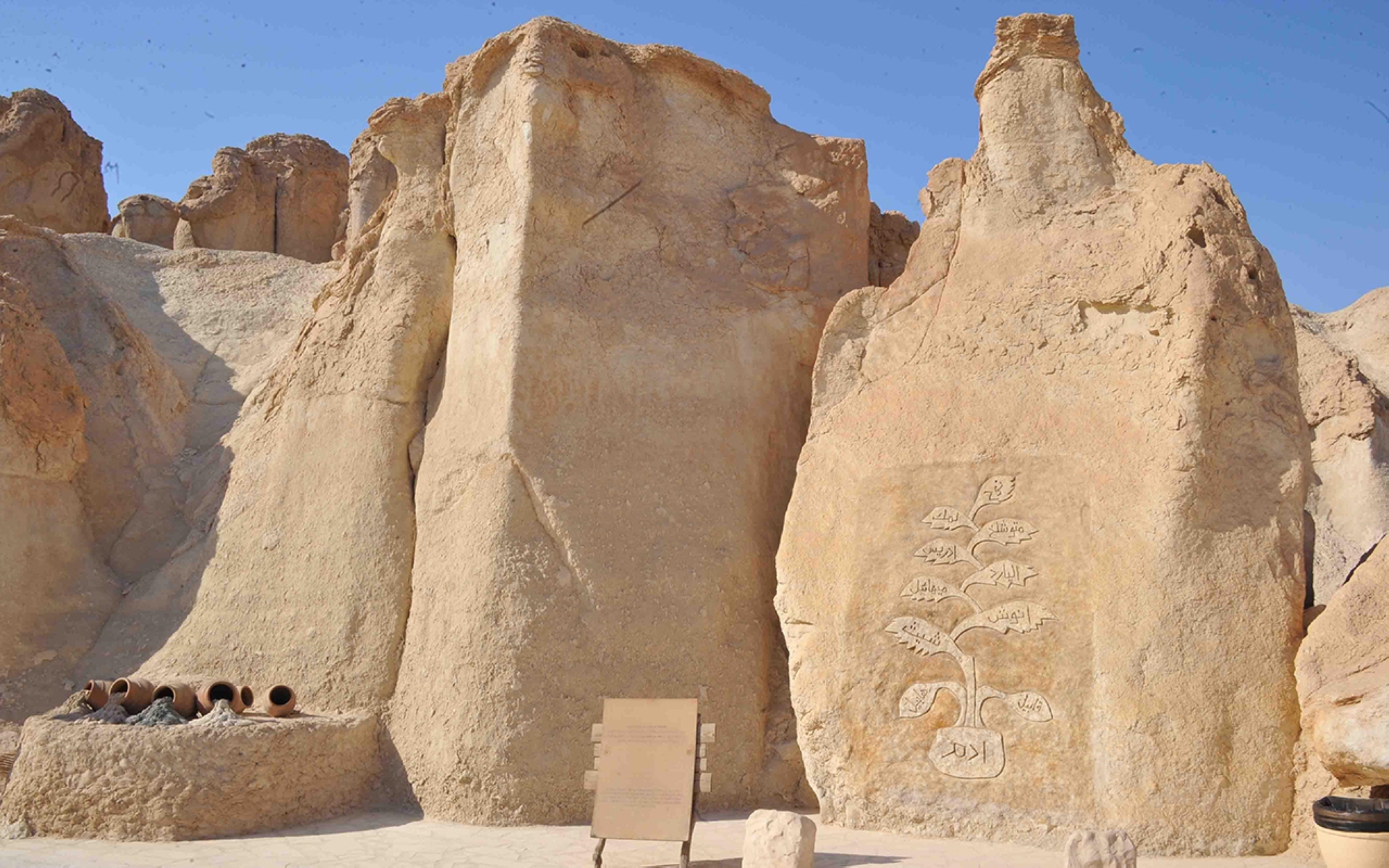
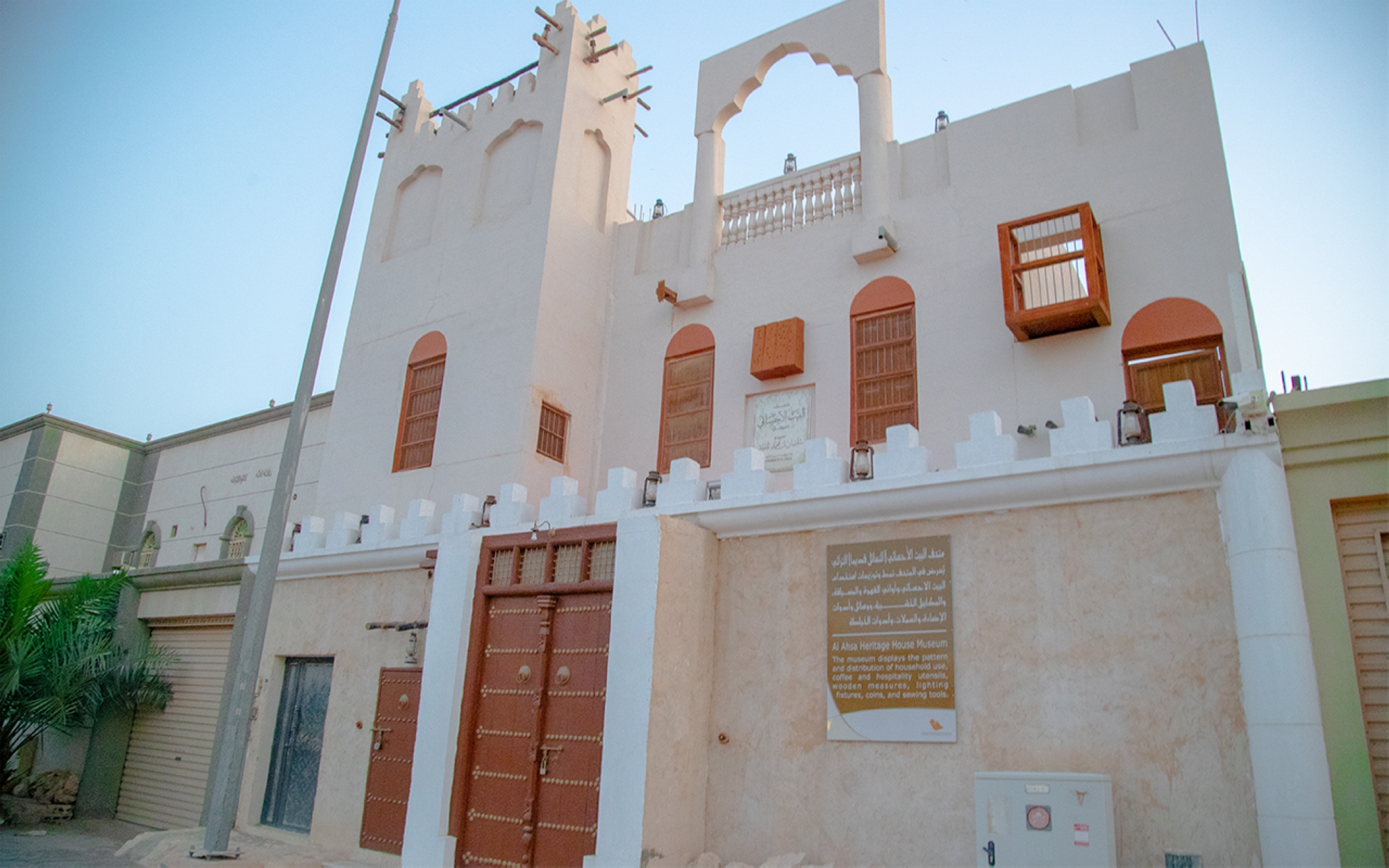
Cultural heritage of al-Ahsa Governorate
Al-Ahsa Governorate is distinguished by its rich cultural heritage and activities that continuously enrich the Saudi, Arab, and global cultural scenes through publications, intellectual achievements, and knowledge contributions. The province showcases its deep-rooted heritage through its museums and cultural institutions.
Museums in al-Ahsa
Al-Ahsa Governorate houses several museums, with a total of eleven, including:
Al-Ahsa National Museum
It holds the region's heritage across various eras. Visitors to the museum can explore the movement of continents, geological times, and the age of the Earth, and compare the region's artifacts with those of the Kingdom as a whole. The museum underscores the significance of the region in agricultural and commercial terms, tracing its importance from ancient times.
Al-Ahsa House Museum (al-Naathel)
The museum occupies an area of approximately 180 m². It is divided into five sections situated in annexes within the outer courtyard of the museum owner's villa. The museum houses a vast collection of heritage items including traditional coffee utensils, Arabian hospitality tools, stone millstones, as well as coins, manuscripts, old maps, and photographs. It also features vintage sewing machines.
Al-Buabid Museum
Located in the Muhasin District of al-Mubarraz City, it is situated within the residence of its owner. The museum consists of a single hall that represents the old traditional market, with sections dedicated to various old-time trades like the grocer, barber, bakery, blacksmith, carpenter, coppersmith, and other traditional crafts.
Al-Khalifa Heritage Museum
Situated within the owner's residential building, the museum covers an area of two hundred m². It contains a vast collection of heritage items of various types, functions, and materials, representing the cultural heritage of the Eastern Province.
Cultural associations
Al-Ahsa has played a prominent role throughout its history in spreading literary and cultural movements across the Arabian Peninsula and its neighboring regions. This prominence is due to the presence of many poets and scholars. Specifically, in the last five centuries, al-Ahsa has been pivotal in disseminating knowledge and science. In its main cities, schools and charitable foundations flourished. Many scholars graduated from these institutions, contributing to writing, teaching, and holding religious positions in al-Ahsa and across the Gulf countries. This role continued until the emergence of modern formal education institutions in contemporary times.
In al-Ahsa Governorate, there are several cultural and social institutions and associations. These include two public libraries, al-Ahsa Literary Club, and a branch of the Saudi Arabian Society for Culture and Arts. Notably, al-Ahsa was the first Saudi city to establish an association dedicated to reviving traditional arts.
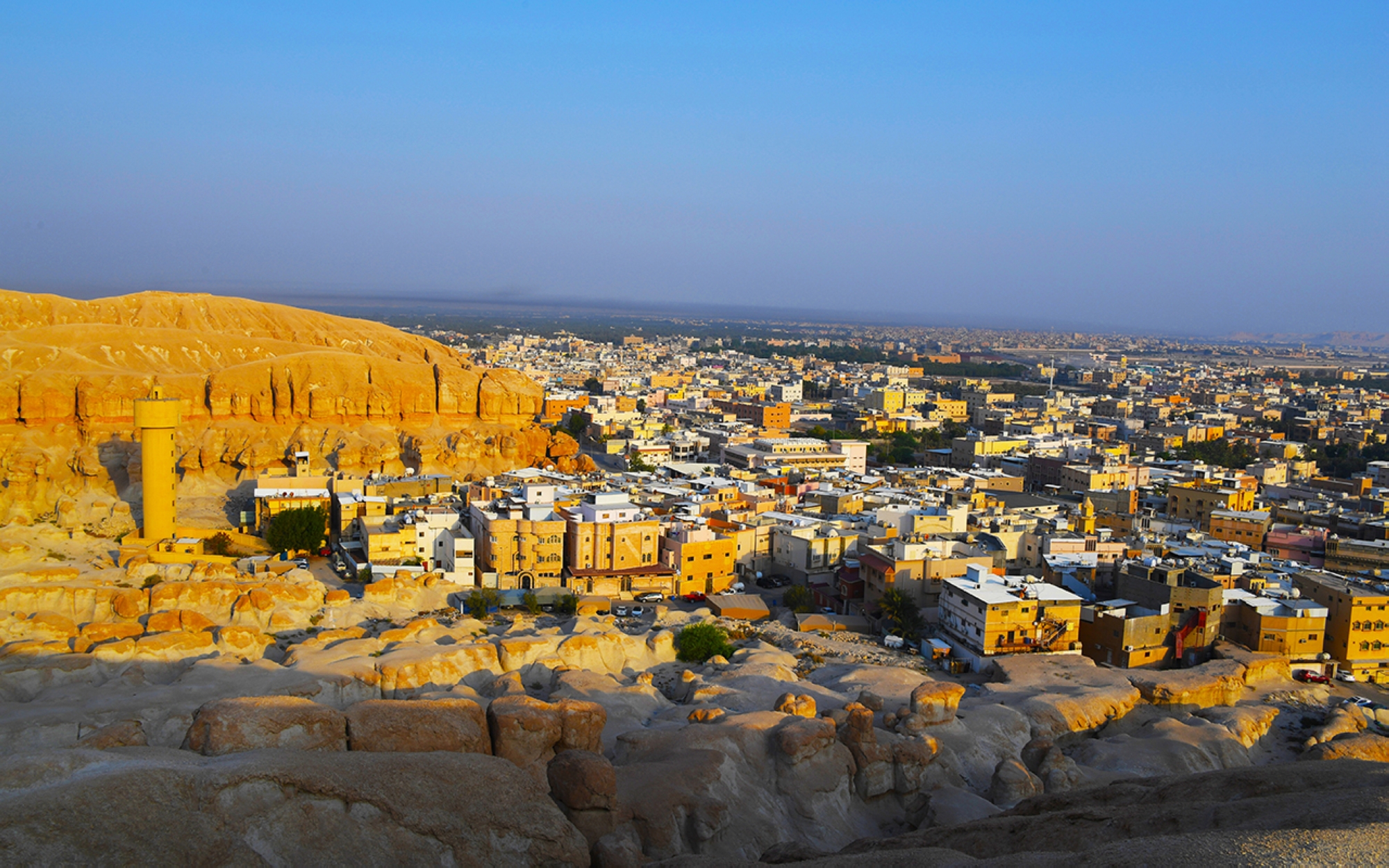
Community of al-Ahsa Governorate
The community of al-Ahsa Governorate is based on historical roots that have strengthened al-Ahsa's presence in cultural and social dimensions. The locals have preserved their customs and traditions throughout different eras.
Al-Ahsa is renowned for numerous social customs. Among them are the public gatherings hosted by some families to welcome loved ones, including relatives, friends, neighbors, and acquaintances. These gatherings are frequented during specific times, especially during occasions such as the Eid holidays.
Moreover, there are cultural councils that began even before the establishment of the Literary Club. A number of intellectuals took the initiative to organize seminars, turning these gatherings into known forums, Monday sessions, panels, Wednesday sessions, and Saturday sessions.
The people of al-Ahsa also observe the tradition of Eid gatherings, where they exchange food and essentials. A well-known custom during Ramadan is the "Butabila," a person who roams the neighborhoods after midnight, beating a drum and chanting supplications to wake the sleeping for Suhoor.
Traditional dishes in al-Ahsa Governorate
Al-Ahsa is famous for its traditional dishes. Some of these include:
Red Bread: Also known as Tannour Bread, its production relies on dates and brown flour.
Masaah Bread: Also called Raqaaq, it is made from a dough consisting of flour, salt, and water.
Wadmah: A type of appetizer, it is made from small fish that are dried, ground, and then mixed with lemon and water. Radishes are dipped into this mixture and consumed.
Harees: In al-Ahsa households, harees is prepared using two key ingredients: wheat and seasoned meat. These are cooked together until tender, then the meat is mashed and blended with the wheat grains until they are fully combined and can be served.
Traditional crafts in al-Ahsa Governorate
The locals' strong ties to their heritage have preserved various traditional crafts that remain vibrant today. The region is rich in raw materials essential for these artisanal industries, such as (date palm derivatives, wood, diverse animal products, stones, clay, gold, and silver). The crafts are diverse in their various activities (blacksmithing, brasswork, pottery-making, mat weaving, textile weaving, bookbinding, spindle spinning, goldsmithing, and woodturning).
To bolster the activities of artisans in al-Ahsa, the Craftsmen Market was established with the aim of preserving heritage and traditional crafts. This move came in the wake of al-Ahsa's inclusion in UNESCO's Creative Cities Network, specifically in the field of traditional crafts and arts.
The Craftsmen Market project enhances the private facilities system in the historic center of al-Hufuf, encompassing numerous artisans in al-Ahsa. This contributes to promoting craft industries by providing a conducive environment for artisans, marketing their work, and promoting tourism in line with the size of these works, contributing to supporting the domestic product under Saudi Vision 2030.
Additionally, the market houses a specialized academy for teaching crafts. Experienced craftsmen impart their skills through this academy to future generations, ensuring the continuation of these crafts, enhancing the economic and touristic value of craft industries, and ensuring their sustainability.
Sports in al-Ahsa Governorate
Al-Ahsa is associated with a variety of sports activities across different disciplines. It hosts fifty-eight sports clubs, including private pitches and fitness centers, and boasts the necessary infrastructure for these activities. Among these facilities is the Prince Abdullah Bin Jalawi Sports City in al-Hufuf City, which spans an area of 280,000 m². The sports city comprises various structures, including the main sports stadium (which houses a football pitch, an athletics track, and its annexes), the city administration building, youth dorms, and their annexes, an indoor swimming pool facility, an indoor sports arena with its extensions, and a training field.
Al-Ahsa Governorate is home to several clubs that compete in various local tournaments. These include al-Adalah Club in al-Hulaylah, established in 1984; al-Rawdhah Club in al-Jishah, founded in 1976 and notable for being the first club from al-Ahsa to participate in the Premier League; and al-Fateh Club, which was founded in 1958 and is based in al-Mubarraz City.
Related quizzes
Related articles

